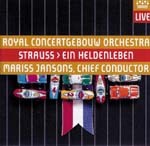This September 4, 2004 Royal Concertgebouw Orchestra concert was the Welcome Concert for its new chief conductor, Mariss Jansons. Technically, the orchestral performance is exemplary, and there are many moments in the recording that are beautiful, though few that are thrilling. As a document of a historic point in the illustrious history of the orchestra, or as a souvenir, this is a more than adequate recording. But when it confronts its competition, it does not emerge as a major contender. This is especially true since there is no coupling included; Ein Heldenleben, at 45 minutes, is all you get.
The main problem, though, is that Jansons allows the self-congratulatory smugness incipient in Strauss’ writing to emerge far too clearly and far too early. The introduction portrays not a hero facing the uncertainties of future struggles, but a retired hero musing over his life’s victories, resting on his laurels. And in memory he sells himself short: The “Adversaries” of the second section don’t sound quite nasty enough and the battle scene is curiously static and emotionally flat.
Now for the beautiful moments. In “The Hero’s Companion” Jansons and violin soloist Alexander Kerr are very effective in presenting the complex and capricious moods in Strauss’ loving portrait of his wife, Pauline. Then, after the battle, Jansons builds a distinguished performance of the last two sections. An unusually unified traversal of the almost three dozen tunes from Strauss’ “Works of Peace” at least justifies the composer’s mood of self-congratulation, and there is an appropriately nostalgic farewell as the hero retreats from life. In all, though, I’d prefer to hear what the Concertgebouw and Jansons will do with Heldenleben after a few years of working together (or what the orchestra already did in its famous previous version under Haitink).
The SACD surround program (5.0 channels) displays a quality that often appears in that format–a tendency for the orchestral sound to distance itself from the listener. After some mental adjustment and a volume boost, though, the sonics wrap the listener in a beautiful acoustic with limited, discrete use of the rear channels. The off-stage trumpets appear not in the rear but backstage to the right. The two binaural channels (SACD and CD) are full-throated and immediate in their presence.
































